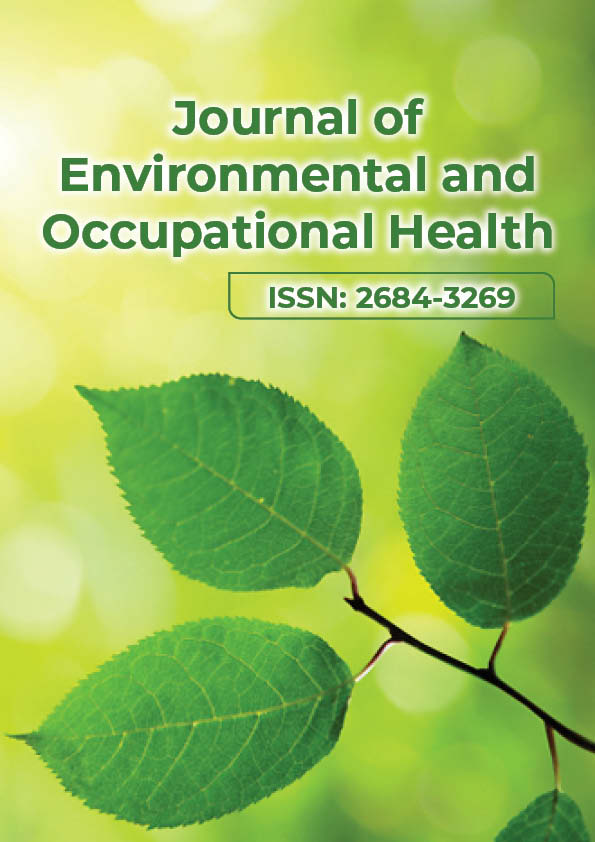Perspective - Journal of Environmental and Occupational Health (2023)
Different Types of Occupational Diseases and its Prevention
Jijun Gao*Jijun Gao, Department of Earth and Environmental Sciences, Bahria University, Islamabad, Pakistan, Email: gaojun48@yahoo.com
Received: 01-Feb-2023, Manuscript No. JENVOH-23-90924; Editor assigned: 03-Feb-2023, Pre QC No. JENVOH-23-90924 (PQ); Reviewed: 17-Feb-2023, QC No. JENVOH-23-90924; Revised: 24-Feb-0023, Manuscript No. JENVOH-23-90924 (R); Published: 03-Mar-2023
Description
Any chronic illness that develops as a result of job or occupational activity is referred to as an occupational disease or industrial disease. It is a component of workplace safety and health. An occupational disease is normally recognised when it can be demonstrated that a given group of employees exhibits higher prevalence of the disease than the general population or other worker populations. The burden of proving that a particular sickness was caused by something other than the worker’s exposure to the workplace is on the employer or insurer under the workers’ compensation laws of many jurisdictions. Occupational diseases are frequently used to describe illnesses covered by national workers’ compensation authorities. Yet, many nations do not provide compensation for some conditions, such as work-related musculoskeletal disorders. Hence, diseases with an occupational origin are referred to as work-related disorders. Yet, this phrase would then cover illnesses with occupational origins that are both compensable and non-compensable. Occupational sickness reports are likely to be lower than real numbers.
Types
Lung diseases
In addition to black lung in coal miners, silicosis in miners, quarry workers, and tunnel operators, and byssinosis in some cotton textile industry workers, occupational lung illnesses include asbestosis in asbestos miners and those who work with friable asbestos insulation. Poor indoor air quality may increase a person’s risk of developing lung and other types of ailments.
Skin diseases
In many nations, occupational skin illnesses are among the top five occupational diseases. Chemicals and having wet hands for extended periods of time at work are the two main causes of occupational skin diseases and disorders. Although eczema is by far the most prevalent, urticaria, sunburns, and skin cancer should all be taken seriously. Skin inflammation brought on by touch with an irritant is known as contact dermatitis owing to irritation. It has been noted that this particular type of dermatitis does not call for antecedent immune system sensitization. Studies have shown that having had or currently having atopic dermatitis increases your likelihood of developing this type of dermatitis. Detergents, acids, alkalies, oils, organic solvents, and reducing agents are some common irritants. The skin is exposed to a potent irritating or caustic substance, which causes the dermatitis to manifest in its acute form. A working accident could result in this exposure. During minutes to hours of exposure to the irritant, the irritating reaction begins to intensify and quickly reaches its peak. After the reaction reaches its maximum intensity, it begins to heal. The decrescendo phenomenon is the name for this process. Acids and alkaline solutions are the two powerful irritants that cause this type of dermatitis most frequently. The skin will become red and swollen, and blisters will start to form as a result of the symptoms.
Prevention
The removal of the irritant from the workplace, the employment of strong irritants in closed systems or automation, irritant replacement or removal, and worker personal protection are all examples of preventative methods. Most nations update and alter the rules governing occupational sickness in order to better prevent and control it, and most of them significantly increase the penalty for violations. Good supply chain management includes the legal regulation of occupational illness prevention, which enables businesses to create supply chain social compliance programmes, ensure their execution, and spot occupational disease dangers.
Copyright: © 2023 The Authors. This is an open access article under the terms of the Creative Commons Attribution Non Commercial Share Alike 4.0 (https://creativecommons.org/licenses/by-nc-sa/4.0/). This is an open access article distributed under the terms of the Creative Commons Attribution License, which permits unrestricted use, distribution, and reproduction in any medium, provided the original work is properly cited.





